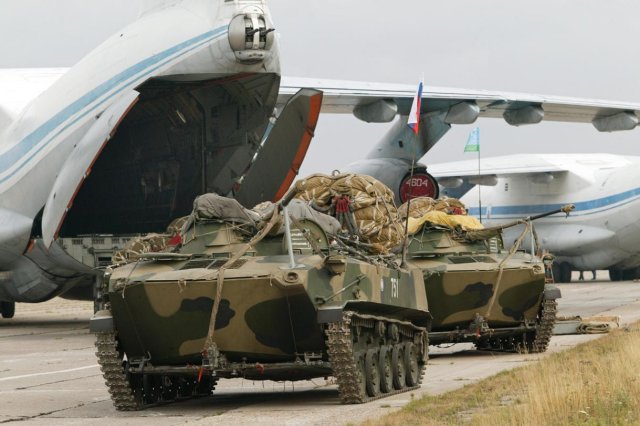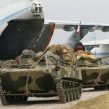
Vostok 2014 and Russia’s Hypothetical Enemies (Part Two)
Publication: Eurasia Daily Monitor Volume: 11 Issue: 172
By:

Vostok 2014, the largest operational strategic military exercise in Russia this year, was recast by the Kremlin as its most grand-scale exercise since the Soviet era; involving upwards of 155,000 personnel. The assets and units taking part suggest that the hypothetical enemy or enemies were state actors, with Russian forces rehearsing territorial defense in the Far East. Some combat elements of the exercise were noteworthy, though the combat service support system was also tested and revealed important developments. Yet, the scenario used during Vostok 2014 contains more than a subtle warning to the North Atlantic Treaty Organization (NATO) against actions close to the Russian periphery (see Part One of this article in EDM, September 23; Rosbalt, September 26).
Beyond the sheer scale of the exercise, Russian media highlighted several high-profile combat elements, especially linked to the final stages of Vostok 2014. These included combined-arms forces repelling a coastal attack; an aviation group destroying a notional “landing force” in Kamchatka; naval infantry and supporting units deployed by stealth to Kamchatka; efforts to improve the use of electronic warfare systems; tests of automated command-and-control systems; the live firing of cruise missiles, S-300 SAMs and Iskander-Ms; rehearsals of operations to counter “enemy saboteurs”; as well as Su-25 landings on highways (Interfax, September 26–25; Rossiyskaya Gazeta, September 21; ITAR-TASS, September 20; Krasnaya Zvezda, September 19).
Vostok 2014 also confirmed continued interest in using unmanned aerial vehicle (UAV) reconnaissance in order to assist artillery in target acquisition. UAV units at Uspenovskiy range monitored the accuracy of artillery strikes and were reportedly used for “correction of fire.” Additionally, UAVs were in used to help assess the performance of units and the “correctness of decisions taken by commanders” (Interfax, September 26–25).
In fact, arguably greater focus was devoted to the non-combat elements associated with moving and redeploying and supplying such large force groupings. This theme was present during Vostok 2010, when the prototype reformed military logistics system revealed multiple failings. Vostok 2014 marks advances on this performance. Deputy Defense Minister Dmitriy Bulgakov praised the rear services for fulfilling their tasks. According to Bulgakov, forces were supplied with 2,000 tons of ammunition and missiles; 25 trains, military transport aircraft and support vessels were used in moving troops and hardware; tracked and wheeled hardware travelled more than 200,000 kilometers, and ships covered 15,000 nautical miles. Overall, the exercise consumed 30,000 tons of petrol, diesel, kerosene and heavy fuel oil (Interfax, September 26; RusVesna, September 19; Krasnaya Zvezda, September 15).
Material-Technical Support (Materialno Tekhnicheskogo Obespechenie—MTO) certainly achieved notable success during the exercise, including transporting battalion tactical groups located in Western Military District (MD), more than 6,000 km to the exercise area in the Russian Far East. These forces repeated the pattern of Vostok 2010 by being transported without weapons, equipment and material, to be equipped from local storage bases. The MTO also experimented with an automated system to improve and simplify logistical orders and requirements. “The use of automated systems at times reduced the time to make decisions on all kinds of logistics and increased the efficiency of logistics system as a whole,” according to defense ministry sources (RIA Novosti, September 20; Interfax, September 26; RusVesna, September 19; Krasnaya Zvezda, September 15). Nonetheless, Defense Minister Sergei Shoigu criticized the MTO for the same failings it exhibited in Zapad 2013: the problem lies in inter-agency and intra-governmental departments coordinating their actions in support of the military (kremlin.ru, September 23).
Although the exercise seemed to be thematically geared toward territorial defense, it did contain offensive maneuvers as well. Despite the use of what some analysts refer to as Russian “hybrid warfare” in Ukraine, there was no attention to this type of clandestine activity during Vostok 2014. The widely reported deaths of three marines who drowned in their BTR armored transporter, for example, occurred during a rehearsal of an amphibious assault (ITAR-TASS, September 23).
In order to conduct such a large-scale operational strategic exercise with multiple areas for both experiment and testing, a complex scenario with numerous vignettes was devised by the Russian General Staff. Earlier in the year, the General Staff claimed that the exercise scenario would not follow a “pre-designed” plan or script and become known to participants only during the exercise. However, it is highly likely that the scenario was indeed meticulously pre-planned and driven to fit the scale and geographical location of Vostok 2014 (Vzglad, September 23).
Indeed, continuity was present in large measure given the exercise location, background of earlier military exercises in the Russian Far East and the manner in which Vostok 2014 was staged, with a similar emphasis on territorial defense, moving of force groupings, as well as the use of air and naval power and tactical missile systems against the same hypothetical opponent: China. Protecting the Kurile Islands clearly also implies a hypothetical conflict with Japan and its ally in the Asia-Pacific Region, the United States. This may explain why the notional enemy in the Pacific Ocean was referred to as representing a “leading NATO member,” as well as sending a signal to the North Atlantic Alliance that Moscow remains concerned about NATO out-of-area operations and the strategic risks involved (Vzglad, September 23). In this context, the exercise was not inherently anti-US. The Russian General Staff remains concerned about the risk of conflict escalation on the country’s periphery, and being drawn into a conflict in which Russia finds itself strategically isolated. This is borne out by the relatively minimal use of Russian regular military forces in the Ukraine conflict in order to control and navigate the risks of conflict escalation.
Vostok 2014, possibly the largest operational-strategic exercise since the collapse of the Soviet Union contained more continuity than novelty in comparison to Vostok 2010. The novelties includes the further efforts to facilitate civil-military cooperation across numerous local government- and federal-level departments, agencies and organizations, first tested in Zapad 2013. Other innovations included the use of automated systems to improve logistics, the utilization of UAV technology to assist in artillery target acquisition, and a greater priority given to missile strikes against the hypothetical adversary. Most elements in the latest incarnation of the Vostok series reveal consistency and ongoing experiments to improve combat capabilities and combat readiness. Its most prominent mark of continuity, however, lies in the reading of the General Staff concerning the potential enemies the Russian state may face in the eastern strategic direction. Vostok 2014, therefore, should serve to highlight the fact that Russian defense and security thinking in its Eurasian setting is not exclusively pre-occupied with the Euro-Atlantic space (see EDM, September 16, 2014; July 12, 2010; July 13, 2010).




